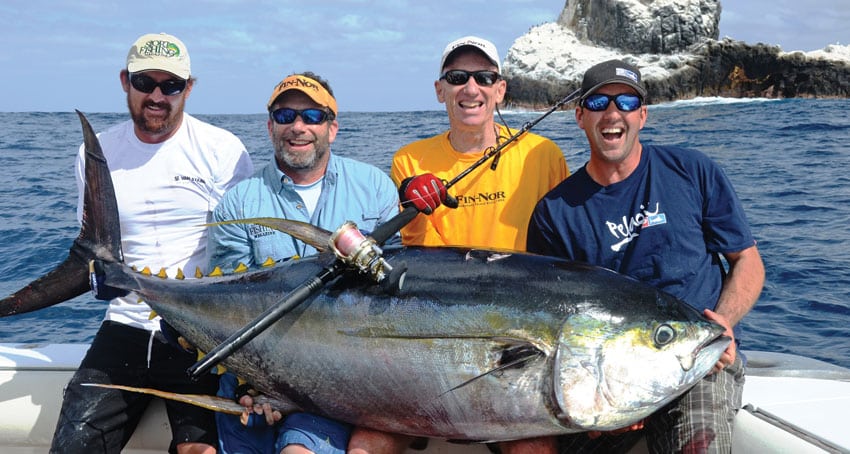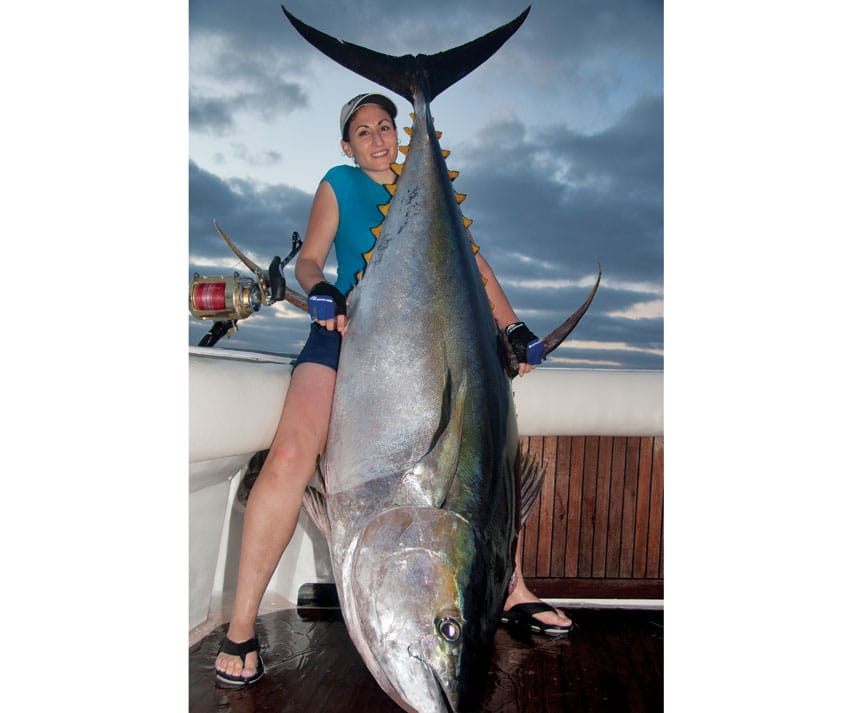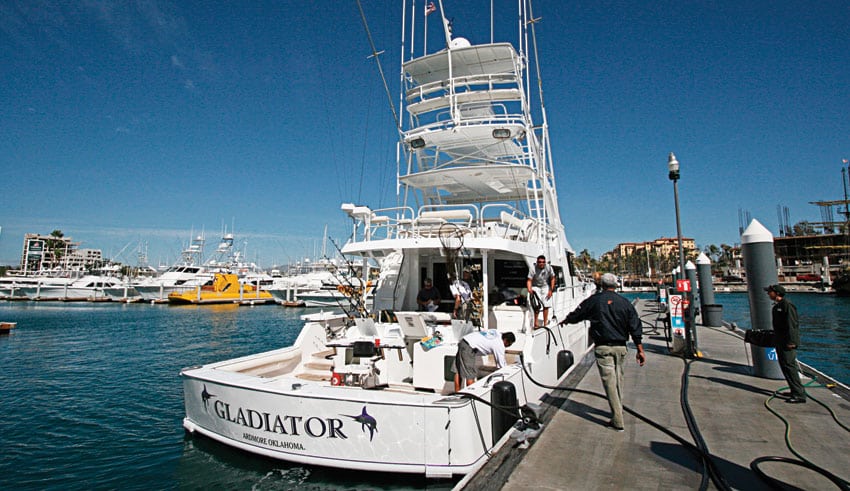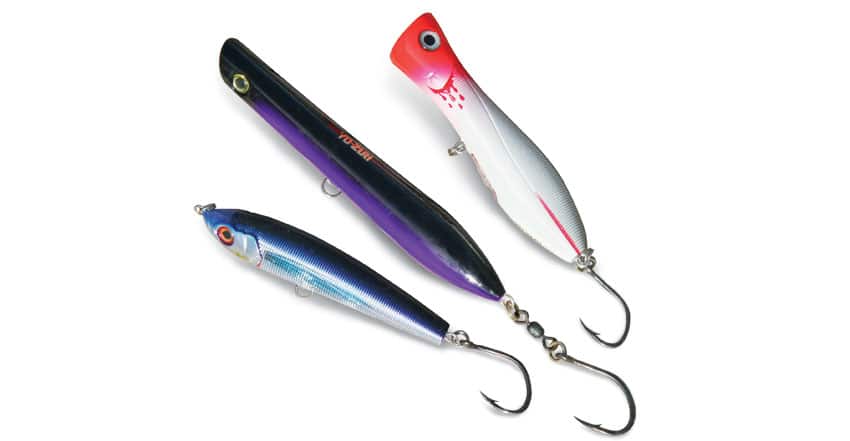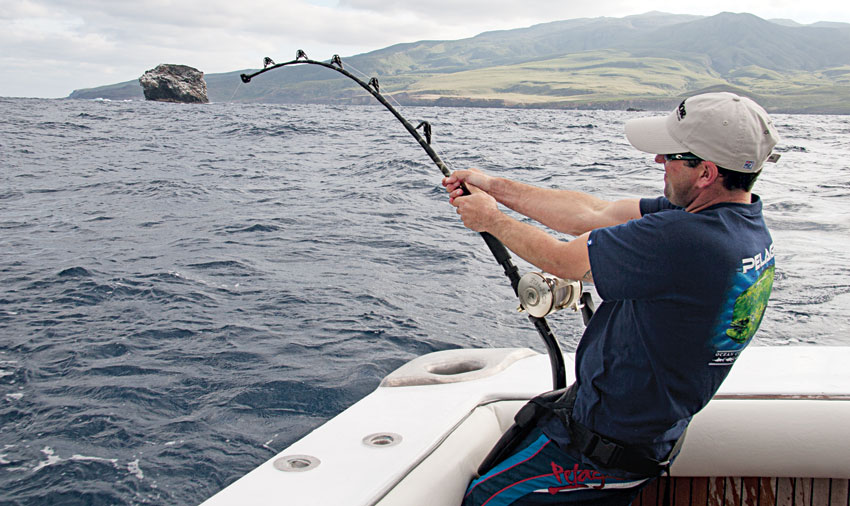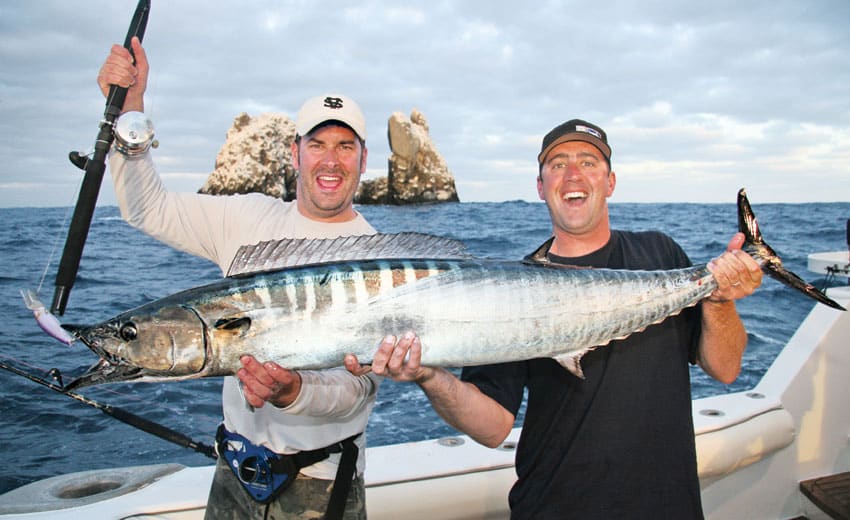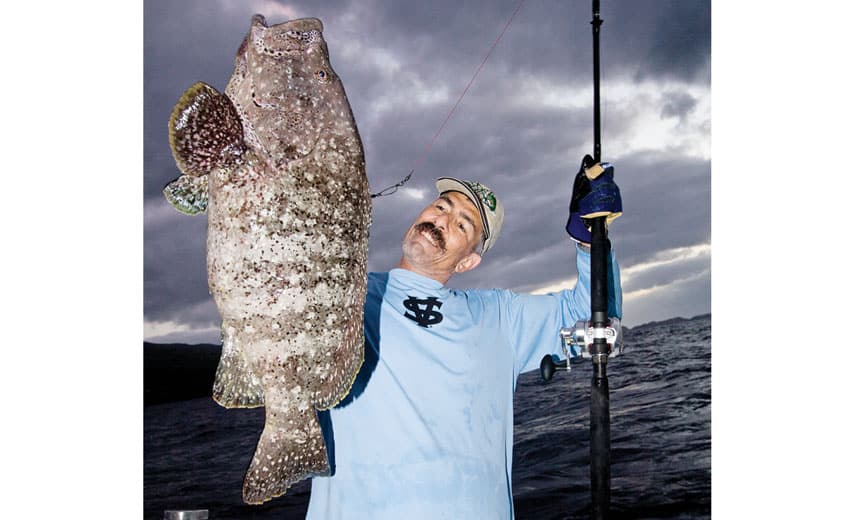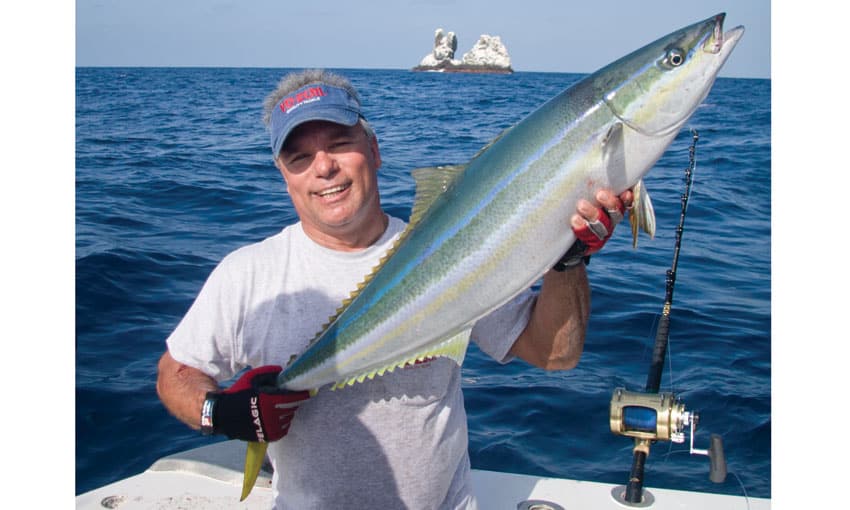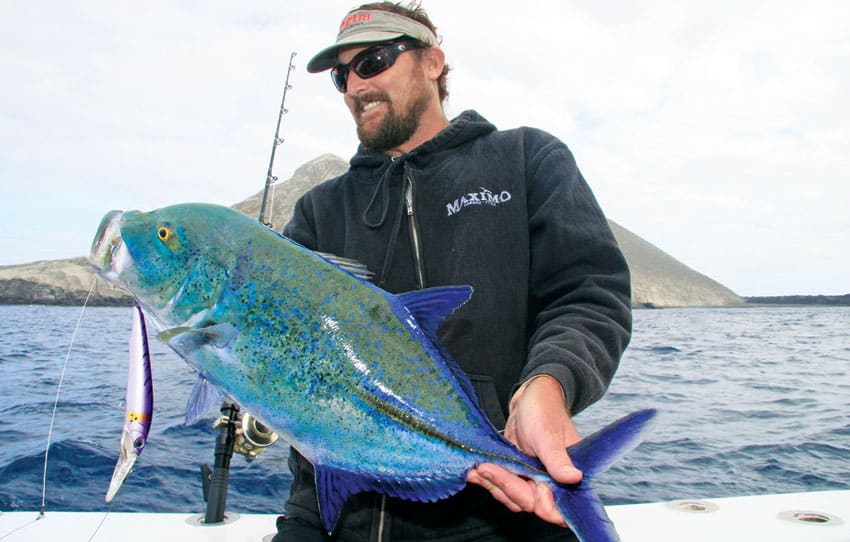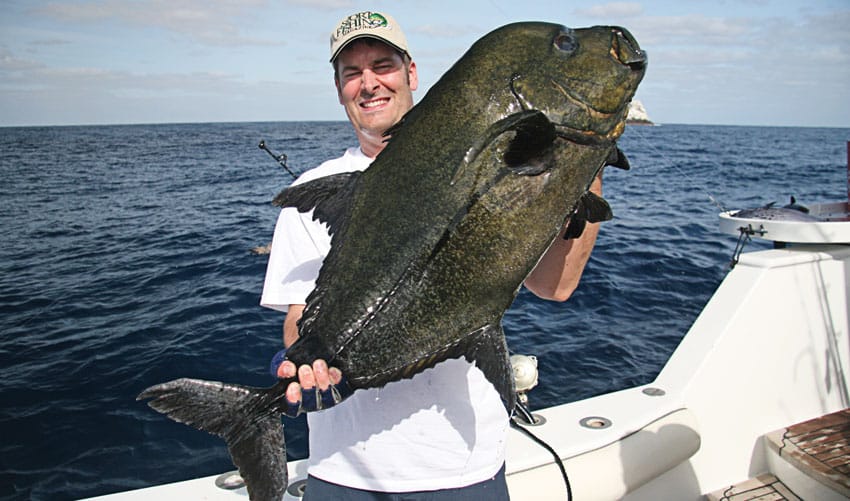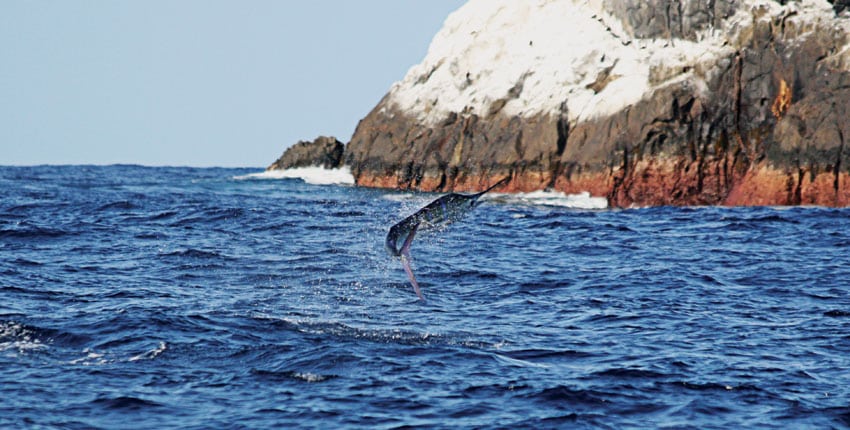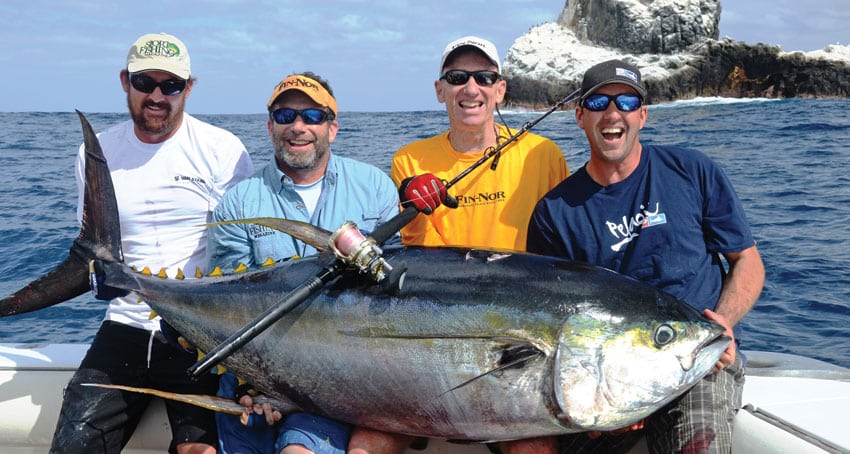
UPDATE: Please note that this article was published in the October 2011 issue of Sport Fishing. Mexico’s Revillagigedo islands are likely closed to U.S. recreational anglers today.
When the call came, it was in the middle of chaos.
“Holy s—t! There’s the cow!”
That was a cow, as in a frighteningly large yellowfin tuna, looking to be well past the 300-pound mark — in fact, thus putting it in the vaunted super-cow class.
The excited yell had come from Capt. Josh Temple aboard the Gladiator, a 78-foot custom, aluminum-hulled sport-fisher based in Cabo.
The reason many of the six anglers aboard didn’t immediately hear the call had to do with their various preoccupations. While the mate, who goes simply by Pepe, kept up a chunk line amidships, from each of the stern corners, Steve Zernia (a charter skipper from Seward, Alaska) and George Large (in charge of Yo-Zuri America) fought yellowfin tuna on spinning gear. Hardly cows, these tuna would be in the 30- to 60-pound range, which was just fine with these anglers, enjoying the unparalleled excitement of an extended yellowfin bite on poppers. (Large had — as expected — brought a substantial arsenal of lures with him; of several tried-and-true Yo-Zuri poppers, the 4inch Sashimi Slider, a topwater lure similar to a stickbait, proved the tunas’ favorite.)
On the bow, Ray More (then with Fin-Nor/Van Staal), had found another species that appreciated the Slider when a wahoo hurtled across the surface to grab the color-changing lures, giving More the chance to try out a new reel, the Van Staal VM 150.
Meanwhile, up on the bow pulpit, Andy Mezirow (the other member of the Seward charter-skipper team) hand-drifted out a live salami (blue) mackerel (Scomber australasicus). He had visions of a striped marlin, having hooked up and released a good stripe less than an hour before.
Yours truly and a co-photographer, Rachel (who conveniently shares my last name), were running around the lower bridge trying to figure out what to photograph next.
That was when, from the upper bridge, I heard Temple’s cow shout.
A Cow Comes A-Calling
By the time I’d rushed over to the port side to peer down into the chunk line, Arturo, the other mate, hurriedly married chunk bait and circle hook as More held the rod, ready to deploy. Moments before, he had managed to release his wahoo to run back and make himself available to dangle a bait for the immense fish I saw charging through the chunk line.
Though the shape remained fairly deep, I could scarcely mistake either what it was or its size. The basis for calling such tuna “cows” could hardly be missed, because it had all the body mass of a large bovine but considerably more grace. Like a minisubmarine, the tuna advertised itself to all those looking down, with yellow finlets aglow.
“Get that bait out there!” Temple hollered.
More did just that, though the huge fish seemed to have disappeared by the time the armed piece of bait began drifting into the chunk line. But a few minutes later, thankfully before the omnipresent whaler sharks snapped up the bait, the yellowfin had returned, lazily sucking in a chunk here or there. When one of those happened to be More’s bait, and the angler’s line came tight, someone on deck shouted, “He’s bit, he’s bit!” With the drag on strike, More waited for the circle hook to bite in, and it did. Then, for a few precious moments, he struggled against the tremendous power as his Fin-Nor Santiago reel screamed to protest the 100-pound braid melting from its spool.
Then suddenly, the fish was gone; all that remained was the hook, having never had sufficient purchase in the fish’s jaw to stay buttoned.
Otherworldly Islands
The Gladiator sat at anchor for all this action just off Roca Partida, the smallest island in Mexico’s Revillagigedo archipelago, about 300 miles southwest of Cabo.
In fact, Roca Partida looks every bit its Spanish name, which translates to “divided rock.” It’s certainly much more an austere rock than an island, lacking vegetation or any real mass. Geologic forces thrust Partida almost straight up out of the Pacific’s depths. It’s definitely not a place you’d want to be shipwrecked — though its rocky, guano-covered sides are so steep, one would be hard-pressed to find a foothold anywhere.
Six anglers had joined the crew (the two mates plus a cook and skipper Danny Alvarez, who has fished the Revillagigedo islands for 15 years) three days earlier to make the long run to the closest island, San Benedicto, running mostly down-sea in the four- to five-foot, white-capped seas over low groundswells of similar size.
We hadn’t lingered long at Benedicto, but long enough to marvel at its otherworldly countenance, with volcanic peaks covered in ancient lava flows, now long eroded in fascinating patterns. Though far larger than Partida, Benedicto appeared just as uninviting.
We also stayed around long enough to drop some jigs in the minimal protection afforded near the island, hooking several leather grouper, which are among the handsomest of eastern Pacific groupers — and among the tastiest.
Exploratory Fishing
During several days in the islands, we shared the waters with only one other boat, a private yacht that had apparently come for the diving. In fact, we were there by virtue of Temple’s securing rare permits to enter what the Mexican government declared in 2002 a protected biosphere. That law prohibits fishing the most productive waters, those within six miles of any island.
For the past three seasons, Temple has enjoyed nearly exclusive access to fish the Revillas. It’s paid off with indisputable success, his anglers bringing to the boat nine (at press time) super-cow yellowfin of 300 pounds or more. They’ve also enjoyed some of the fastest fishing in the world for wahoo, with access to fish the seasonal hordes of the prized mackerel that concentrate near structure — in this case, along the steep drop-offs just around the islands.
Acquiring the coveted permits became a mission for Temple and took literally years of perseverance to accomplish. In 2009, armed with all necessary paperwork, Temple took his first group into the islands.
“Just after we pulled away from that first check-in at the Mexican Navy base on Socorro, we put lines in and immediately started hooking fish,” he says. “For six days on that first trip, we had the kind of action you have to experience to believe.”
Temple says his trips around Clarion, Socorro, San Benedicto and Roca Partida islands are still exploratory. “As far as I’m concerned, we’ve only just begun to scratch the surface when it comes to fishing the Revs.”
That said, Temple points out, “We’ve managed to bring to the boat at least one tuna over 300 pounds during our past five trips” — with the largest at 367.
Patience Pays for Monsters
Without a doubt, super cows are the primary targets on Revillas trips, and Temple likes to drift or anchor, and feed the tuna a combination of chunks and live baits (goggle eyes, green-back mackerel or the larger salami mackerel). “If skipjack or bonito are schooling and available, we love to fish them as live baits,” Temple says, since those certainly tend to weed out the smaller yellowfin. “The average-size yellowfin in these waters that gobbles down a skipjack will be well over 200 pounds.”
Temple targets the big gals specifically. He says that if you simply put a bait out, the odds are high that smaller tuna or wahoo will find it first. Instead, Temple says, “I concentrate on fishing larger baits in proven big-fish locations.” He anchors on a favored spot and chums continuously until el grande yellowfin start showing behind the boat.
“While it’s certainly tempting to pitch baits or chunks to the numerous tuna less than 200 pounds you’ll see prowling the chunk line, I try to be adamant about telling anglers to remain patient until that 300-pounder shows up. That’s the time to put hook baits in.”
And that, Temple says, requires a lot of restraint. “Most guys automatically want to feed a 200-pounder when it cruises by, five feet off the transom, so I have to coach them to be patient. The last thing you want is to have anglers hooked up to smaller yellowfin then, while everyone’s tied up, a school of 300-pounders shows up.”
Interestingly, Temple says he’s found little need for the fluorocarbon leaders so important where tuna are hit hard by anglers. These yellowfin aren’t terribly shy. (In fact, more than once, Temple’s anglers have just about hand-fed chunks to cows swimming by the transom in a chunk line.)
If the world record for yellowfin is to be broken again, odds are good it will be a Revillagigedo fish.
Untapped Billfish
That more than tuna prowl the Revillas is hardly surprising, as Mezirow proved by hooking a striped marlin barely a stone’s throw off Roca. Another time, Temple recalls anglers jigging for grouper near Roca Partida, when “up from the depths swam a black marlin of grander size, checking us out. We threw everything we had at it, but a fish that size isn’t too interested in iron or even small live baits.”
While the billfish fishery remains largely untapped — “There are concentrations of billfish out here begging to be tapped into” — Temple says they’ve caught sails, stripes, blue and black marlin in these waters.
He’s also curious about unrealized opportunities for popping around shorelines and jigging the drop-offs, though at least the latter has been an occasional activity — as it was on my foray into these islands.
During a limited bit of dropping metal jigs, we failed to get a lot of variety, but did get into some outstanding action for one of the eastern Pacific’s more colorful groupers, the leather grouper, which seem to be particularly abundant and put up a fair fight. Also, I’m here to report that leather grouper are outstanding eating. (There have apparently been no ciguatera issues in these waters.)
The occasional jigging efforts on the Gladiator have also produced such species as broomtail grouper, bluefin trevally and rainbow runner. Surprisingly, not many true snappers have been caught in these waters so far, though Temple says he expects that list to grow as they spend more time exploring deepwater drop-offs around the islands in coming years.
The most super of the super cows hooked on this trip came unbuttoned shortly after More hooked it, as noted earlier. Whether that was 300 pounds or 380, we’ll never know. But we did bring aboard one we didn’t weigh, the sheer bulk of which assured us of its super-cow status, after Rachel duked it out in an all-out stand-up battle at the rail for an hour. It wasn’t the biggest taken aboard the Gladiator, but for most yellowfin enthusiasts, it still qualifies as that fish of a lifetime.
